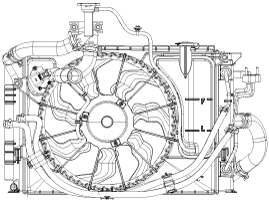 Kia Soul: Coolant Replacement And Air Bleeding
Kia Soul: Coolant Replacement And Air Bleeding
Kia Soul 2014-2019 PS Service Manual / Engine Mechanical System / Cooling System / Coolant Replacement And Air Bleeding
Never remove the radiator cap when the engine is hot. Serious
scalding could be caused by hot fluid under high pressure escaping from
the radiator.
|
When pouring engine coolant, be sure to shut the relay box lid
and not to let coolant spill on the electrical parts or the paint. If
any coolant spills, rinse it off immediately.
|
| 1. |
Make sure the engine and radiator are cool to the touch.
|
| 2. |
Remove radiator cap (A).
|
| 3. |
Remove the engine room under cover.
(Refer to Engine And Transaxle Assembly - ŌĆ£Engine Room Under CoverŌĆØ)
|
| 4. |
Loosen the drain plug (A) and drain the coolant.
|
| 5. |
Tighten the radiator drain plug securely.
|
| 6. |
After draining engine coolant in the reservoir tank, clean the
tank.
|
| 7. |
Fill the radiator with water through the radiator cap and tighten
the cap.
|
| 8. |
Start the engine and allow to come to normal operating temperature.
Wait for the cooling fans to turn on several times. Accelerate the engine
to aid in purging trapped air. Shut engine off.
|
| 9. |
Wait until the engine is cool.
|
| 10. |
Repeat steps 1 to 8 until the drained water runs clear.
|
| 11. |
Fill fluid mixture with coolant and water (55~60%) (except for
North America, Europe and China : 45~50%) slowly through the radiator
cap.
Push the upper/lower hoses of the radiator so as bleed air easily.
|
| 12. |
Start the engine and run until coolant circulates.
When the cooling fan operates and coolant circulates, refill coolant
through the radiator cap.
|
| 13. |
Repeat step.11 until the cooling fan 3 ~ 5times and bleed air
sufficiently out of the cooling system.
|
| 14. |
Install the radiator cap and fill the reservoir tank to the "MAX"
(or "F") line with coolant.
|
| 15. |
Run the vehicle under idle until the cooling fan operates 2 ~
3 times.
|
| 16. |
Stop the engine and wait coolant gets cool.
|
| 17. |
Repeat 10 to 15 until the coolant level doesn't fall any more,
bleed air out of the cooling system.
|
 Components Location
Components Location
1. Side air guard
2. A/C condenser
3. Radiator
4. Cooling fan & reservoir tank assembly
5. Radiator lower hose
6. Radiator reservoir hose
7. Radiator cap & fil ...
 Cooling Fan Components
Cooling Fan Components
1. Cooling fan mounting retainer
2. Torque washer
3. Cooling fan
4. Fan motor
5. Cooling fan shroud
6. Cooling fan resistor
...
See also:
Seats
Front seat
(1) Forward and backward
(2) Seatback angle
(3) Seat cushion height (DriverŌĆÖs seat)*
(4) Seat warmer*
(5) Headrest
(6) Armrest (DriverŌĆÖs seat)*
Rear seats
(7) Folding the seat ...
Cylinder Head Disassembly
Identify MLA(Mechanical lash adjuster), valves, valve springs
as they are removed so that each item can be reinstalled i ...
Manual transaxle operation
The manual transaxle has 6 forward gears.
This shift pattern is imprinted on the shift knob. The transaxle is fully synchronized
in all forward gears so shifting to either a higher or a lower gea ...





